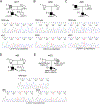BMP4 mutations in tooth agenesis and low bone mass
- PMID: 31128441
- PMCID: PMC6639811
- DOI: 10.1016/j.archoralbio.2019.05.012
BMP4 mutations in tooth agenesis and low bone mass
Abstract
Objective: To identify an uncommon genetic cause of tooth agenesis (TA) by utilizing whole exome sequencing (WES) and targeted Sanger sequencing in a cohort of 120 patients with isolated TA.
Design: One deleterious mutation in the gene encoding bone morphogenetic protein 4 (BMP4) was identified in 6 unrelated patients with TA by WES. After that, the coding exons of BMP4 were examined in 114 TA patients using Sanger sequencing. Dual-energy X-ray absorptiometry (DEXA) was used to measure the bone mineral density of patients who carried a BMP4 mutation. Finally, preliminary functional studies of two BMP4 mutants were performed.
Results: We detected 3 novel missense mutations (c.58 G > A: p.Gly20Ser, c.326 G > T: p.Arg109Leu and c.614 T > C: p.Val205Ala) and 1 reported mutation in the BMP4 gene among 120 TA probands. The previously reported BMP4 mutation (c.751C > T: p.His251Tyr) was associated with urethra and eye anomalies. By extending the pedigrees, we determined that the tooth phenotypes had an autosomal dominant inheritance pattern, as individuals carrying a BMP4 mutation exhibit different types of dental anomalies. Interestingly, we observed that patients harboring a BMP4 mutation manifested early onset osteopenia or osteoporosis. Further in vitro functional assays demonstrated that two BMP4 mutants resulted in a decreased activation of Smad signaling. Therefore, a loss-of-function in BMP4 may contribute to the clinical phenotypes seen in this study.
Conclusions: We identified 4 mutations in the BMP4 gene in 120 TA patients. To our knowledge, this is the first study to describe human skeletal diseases associated with BMP4 mutations.
Keywords: BMP4; Dental anomalies; Osteopenia; Osteoporosis; Tooth agenesis.
Copyright © 2019 Elsevier Ltd. All rights reserved.
Conflict of interest statement
Conflict of interestre
The authors have no conflict of interest to declare.
Figures




Similar articles
-
Mutations in LRP5 and BMP4 are associated with mesiodens, tooth agenesis, root malformation, and oral exostoses.Clin Genet. 2022 Oct;102(4):333-338. doi: 10.1111/cge.14183. Epub 2022 Jul 2. Clin Genet. 2022. PMID: 35754005
-
Functional evaluation of a novel tooth agenesis-associated bone morphogenetic protein 4 prodomain mutation.Eur J Oral Sci. 2013 Aug;121(4):313-8. doi: 10.1111/eos.12055. Epub 2013 May 18. Eur J Oral Sci. 2013. PMID: 23841782 Free PMC article.
-
TGFB3 and BMP4 polymorphism are associated with isolated tooth agenesis.Acta Odontol Scand. 2012 May;70(3):202-6. doi: 10.3109/00016357.2011.629626. Epub 2011 Dec 23. Acta Odontol Scand. 2012. PMID: 22191848
-
Genetic analysis: Wnt and other pathways in nonsyndromic tooth agenesis.Oral Dis. 2019 Apr;25(3):646-651. doi: 10.1111/odi.12931. Epub 2018 Jul 23. Oral Dis. 2019. PMID: 29969831 Free PMC article. Review.
-
Genes affecting tooth morphogenesis.Orthod Craniofac Res. 2007 Nov;10(4):237-44. doi: 10.1111/j.1601-6343.2007.00407.x. Orthod Craniofac Res. 2007. PMID: 17973693 Review.
Cited by
-
Computational Insights into the Structural and Functional Impacts of nsSNPs of Bone Morphogenetic Proteins.Biomed Res Int. 2022 Jul 4;2022:4013729. doi: 10.1155/2022/4013729. eCollection 2022. Biomed Res Int. 2022. Retraction in: Biomed Res Int. 2024 Jan 9;2024:9891352. doi: 10.1155/2024/9891352. PMID: 35832847 Free PMC article. Retracted.
-
Mutations that prevent phosphorylation of the BMP4 prodomain impair proteolytic maturation of homodimers leading to lethality in mice.Elife. 2025 May 29;14:RP105018. doi: 10.7554/eLife.105018. Elife. 2025. PMID: 40439112 Free PMC article.
-
Identification of novel candidate genes associated with non-syndromic tooth agenesis in Mongolian families.Clin Oral Investig. 2023 Dec 29;28(1):56. doi: 10.1007/s00784-023-05415-2. Clin Oral Investig. 2023. PMID: 38157055 Free PMC article.
-
Effect of the Abnormal Expression of BMP-4 in the Blood of Diabetic Patients on the Osteogenic Differentiation Potential of Alveolar BMSCs and the Rescue Effect of Metformin: A Bioinformatics-Based Study.Biomed Res Int. 2020 Jun 7;2020:7626215. doi: 10.1155/2020/7626215. eCollection 2020. Biomed Res Int. 2020. PMID: 32596370 Free PMC article.
-
Identification of bone morphogenetic protein 4 in the saliva after the placement of fixed orthodontic appliance.Prog Orthod. 2021 Jul 12;22(1):19. doi: 10.1186/s40510-021-00364-6. Prog Orthod. 2021. PMID: 34250561 Free PMC article.
References
MeSH terms
Substances
Grants and funding
LinkOut - more resources
Full Text Sources

